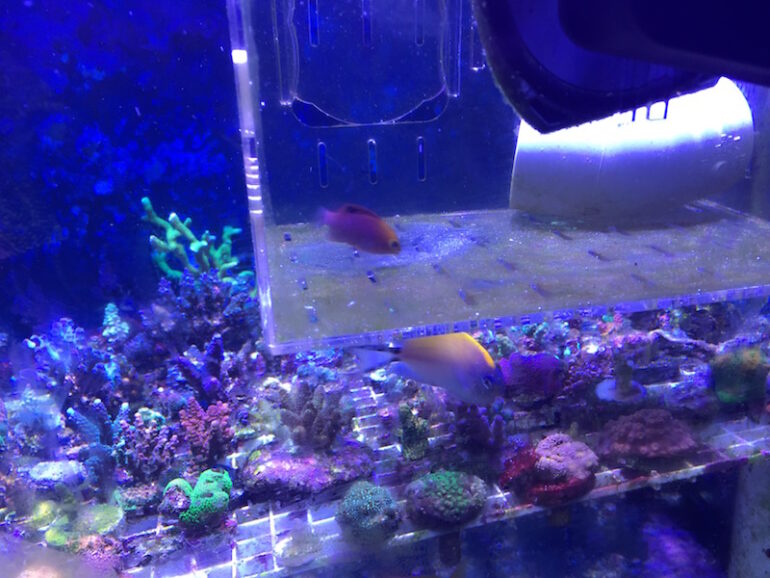A simple acclimation process
The following process is one that should be employed for all normal acclimation of animals from one system to another.
STEP 1
If possible, determine the water quality values for the aquarium that the fish will be coming from and adjust the receiving aquarium’s values to a similar range. As mentioned, if the values can be made nearly identical, no acclimation process is even required.
STEP 2
The fish must be transported from one aquarium to another in a manner that minimizes additional stress. The fish should be kept in the dark, and supplemental aeration or oxygen must be used for any transport lasting longer than about 30 minutes. Heat or ice packs may be required to maintain a proper water temperature during long transports. If you have control over it, treat the transport container carefully to avoid exposing the fish to any undo physical shock. Remember that losses during transport are always skewed to the very end of the transport time, so delays must be minimized.
STEP 3
Once at the destination aquarium, dim the room lights and float the sealed bag in the aquarium for 10 to 15 minutes. This is sufficient to equalize the water temperatures.
STEP 4
If you don’t already know the values, check the pH and specific gravity of the aquarium and the shipping water. Long-duration shipments (greater than 24 hours) need to be handled differently and are described below. Avoid any increases in specific gravity greater than .004 units—adjust the receiving tank’s specific gravity to match that in the transport bag.
STEP 5
Open the bag, and roll the top in on itself to form a floatation collar. Remove as much of the shipping water as you can while still keeping the fish in an adequate volume of water. Add to the bag a volume of aquarium water that equals 25% of the volume of water in the bag. (For example, if the bag holds 8 ounces of water, you would add 2 ounces of tank water.) The fish is now 20% equilibrated. Wait five minutes.
STEP 6
Remove enough water from the bag to reduce it to its starting volume, and now add a volume of tank water that equals 50% of the volume in the bag. Wait another five minutes.
STEP 7
Remove water from the bag a third time, again reducing it to the starting volume, then add a volume of tank water that equals 100% of the water in the bag (the bag is now 75% equilibrated). Wait five minutes.
STEP 8
Release the specimen into the tank. Most aquarists avoid letting any of the acclimation water enter their tank. If the animal has been released into a tank housing other fish, monitor them very closely for signs of compatibility problems.
Special cases
Not every acclimation can be handled by the simple method described above. The following are special cases that may require aquarists to deviate from the regular procedure:
- During the winter, a shipment of fish may arrive severely chilled. Remove the bags from the shipping box, and then remove any outer plastic bags or paper wrappings and lay the bags in the room in dim light. Do not float the bags in the aquarium yet, as this will reduce proper gas exchange. After 30 minutes or so, the fish’s shipping water will have warmed up a bit and the simple acclimation procedure can begin.
- Sometimes, bags are punctured during shipment, and some invertebrates are shipped “damp.” In these cases, no acclimation is possible. Just place the animal directly into the aquarium.
- Any animal that arrives moribund (not moving or upside-down in the shipping bag) is undergoing peracute stress [a form of stress rapidly leading to death]. Eliminating this takes precedence over trying to minimize the perceived acute stress of not acclimating the animal properly. Adding the fish directly to the aquarium as in step 2 is actually the best course of action. Some fish that arrive barely breathing can actually be revived by holding their mouth open into a gentle current to help ventilate their gill chambers.
- Starfish, sea urchins, octopuses, and some crustaceans are extremely sensitive to changes in pH and specific gravity.
- Marine fish do not tolerate significant increases in specific gravity. If the difference is .003 or greater, consider lowering the specific gravity of the receiving aquarium to more closely match that of the shipping water. On the other hand, fish handle reductions in specific gravity very well. Fish can be moved from high to low specific gravity through the normal acclimation process, even if the change is as great as .006 specific gravity units.
Acclimation is an important technique and is a necessary first step when introducing fish to a new aquarium. The most common mistake seen is when people begin to think, “If acclimation is so important, then a really long acclimation time must be even better.” Stick to reasonable acclimation rates, and your fish will respond well—and they’ll thank you by thriving in their new home.



